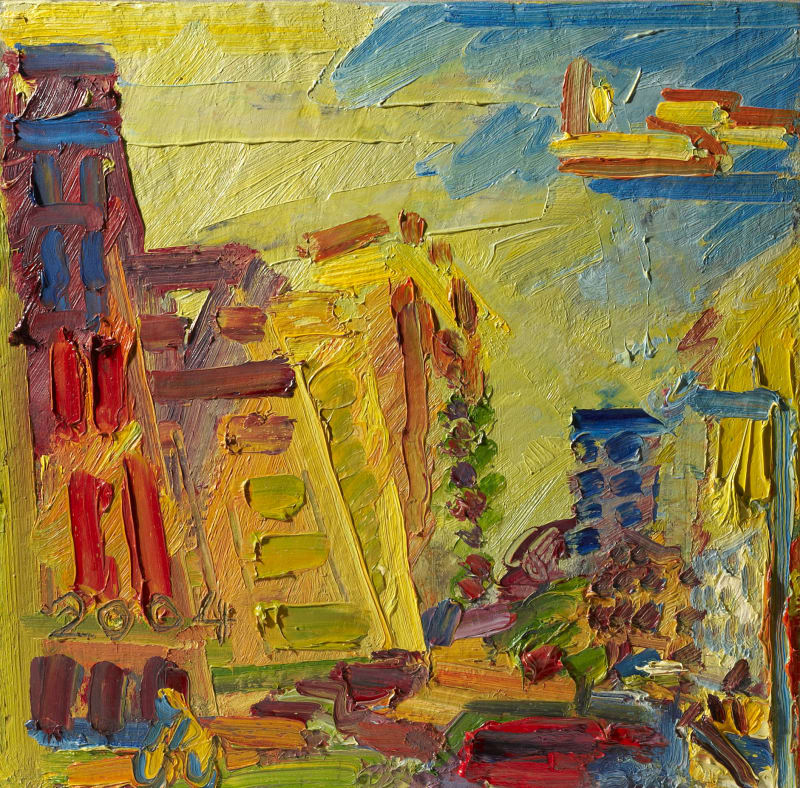Other name: Frank Helmut Auerbach
Painter Frank Auerbach was born to Jewish parents in Berlin, Germany in 1931; his father was a lawyer and his mother a former art student. In 1939, at the age of eight, he was sent to England to escape persecution at the hands of the Nazis. His parents, who remained behind, perished in the Holocaust. Auerbach spent his childhood at Bunce Court, a progressive boarding school in Kent for Jewish refugees, where he excelled not only in art but also in drama. In 1947 he was naturalised a British citizen and moved to London, deciding, at the age of 16, to become an artist. He attended painting classes at the Hampstead Garden Suburb Institute, going on to St Martin's School of Art, where he studied between 1948 and 1952, meeting fellow pupil Leon Kossoff in the Antique Room. Both subsequently attended David Bomberg's revolutionary life drawing evening classes at the Borough Polytechnic, an antidote to their more formal teaching, which continued at the Royal College of Art (1952-55). In 1954 Auerbach took over Kossoff's former Camden Town studio (previously occupied by German émigré artist and activist Gustav Metzger, who also studied with Bomberg), where he continues to live and work to this day.
In 1956, shortly after completing his studies, Auerbach was given his first solo exhibition at Helen Lessore's Beaux-Arts Gallery (his work was also exhibited at the Ben Uri Gallery, alongside other Jewish artists, in the same year). He continued to exhibit regularly at the Beaux-Arts until 1963, gaining a reputation as a young figurative painter of great power, and since 1965, he has been represented by the Marlborough Galleries in London. Early in his career, Auerbach also taught part-time in a variety of posts, including a day a week at a Sussex girls' school (where the headmistress 'regularly invited him to share a lunch of scallops and gin' [cited Lampert 2019, p. 72]), and Sidcup, Bromley and Camberwell Schools of Art. At the latter, he worked one day a week from 1958-65, providing 'the strongest antidote possible' to William Coldstream's mathematical system. Under his powerful influence the studio became 'deep in charcoal, heavily worked paper, and paint scrapings', leaving a legacy that continued long after he moved on to the Slade (cited MacDougall 2019, p. 82). Auerbach is often associated with the circle of figurative painters including Michael Andrews, Francis Bacon, Lucian Freud and Leon Kossoff, famously referred to by R. B. Kitaj in 1976, as 'the School of London', although Auerbach has stated that he does not feel part of this or any group. Freud, one of Auerbach's closest friends and a collector of his work, bequeathed a collection of 45 Auerbach paintings and drawings to the nation, distributed to museums throughout the UK in 2011. In 1978 Auerbach was the subject of a major exhibition at the Hayward Gallery in London and in 1986 his work was selected for the British Pavilion of the 42nd Venice Biennale at which he was awarded the Golden Lion along with Sigmar Polke.
Auerbach has made some of the most resonant and inventive paintings of people and urban landscapes of recent times. He works every day, returning continuously to a narrow range of subjects: landscapes near his Mornington Crescent studio in North London, and portraits featuring a relatively small number of sitters, many of whom he has painted weekly over a number of years, including E. O. W. (Estella Olive West), Juliet Yardley Mills, his wife Julia (née Wolstenholme) and art historian and curator Catherine Lampert. Auerbach spends a long time on each painting, making many preliminary drawings. In the early years, he would paint on top of the previous day's work, creating work of sculptural proportions, including Head of Helen Gillespie, painted between 1962 and 1964 (on loan to Ben Uri Collection). Since the 1960s, however, Auerbach has scraped down the whole surface before the next attempt, each work involving numerous discarded versions, before the final image emerges. For practical reasons, he does not paint landscapes from life but rather works from drawings created on-site. Auerbach often cites his admiration for old and modern masters including Rembrandt, Constable, Rubens and Picasso. As well as acknowledging their influence and the importance of the history of painting, he is also inspired by the intimacy of their subjects. At an exhibition at the National Gallery in 1994 he made direct reference to the gallery's collection of paintings by Rembrandt, Titian and Rubens including paintings made after Titian's Bacchus and Ariadne, from the 1970s and Rubens's Samson and Delilah made in 1993.
Auerbach continues to live and work in London. His work is represented in numerous UK collections including the Ben Uri Collection, the British Museum, the National Gallery and Tate. An Auerbach retrospective was held at Tate Britain in 2015.


